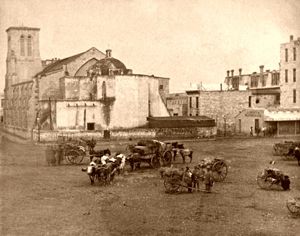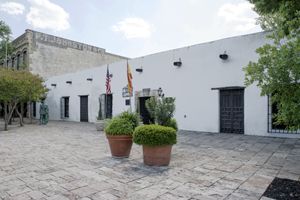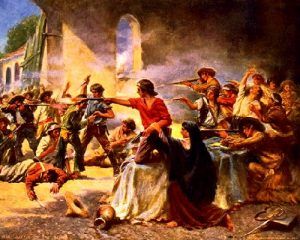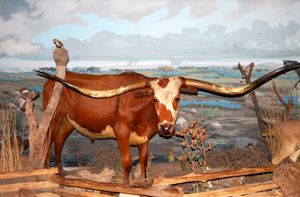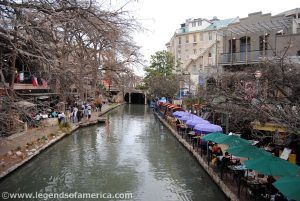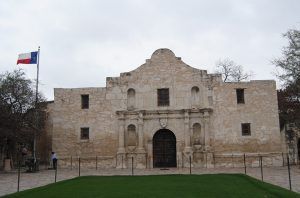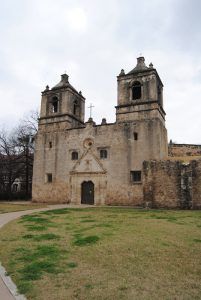
Downtown San Antonio, Texas by Jonathan Cutrer, Wikimedia.
“You may all go to hell, and I will go to Texas.”
— Davy Crockett, after losing his Tennessee bid for the U.S. Congress.
Fort Sam Houston – Mother-in-law of the Army
Ghost Children upon San Antonio’s Railroad Tracks
A Grisly Past at the Sheraton Gunter Hotel
Haunted Menger Hotel in San Antonio
Mission San Antonio de Valero – The Alamo
Capturing the spirit of Texas, San Antonio is a Mecca for history buffs. From its Native American occupation to Spanish explorers’ discovery, old missions, the Battle of the Alamo, and the Old West, the history and attractions of this beautiful city can entertain visitors for days.
When Spanish expeditions first explored the area in 1691 and 1709, it was already occupied by a small Indian community called the Yanaguana, established in the San Pedro Springs area. The first Spanish explorers named the San Antonio River because it was the feast day of St. Anthony.
Father Antonio Olivares founded the city in 1718 when he established Mission San Antonio de Valero.
Soon, five Spanish missions, chartered by the Canary Islanders, were located along the river. The presidial captain’s house (later the Spanish Governor’s Palace) was completed on the Military Plaza in 1749, and San Fernando de Béxar Church was built by 1758. In 1773, San Antonio de Béxar became the capital of Spanish Texas.
By 1778, the settlement’s population of more than 2,000 comprised poor Indians and settlers, and visitors described it as “miserable.”
By 1795, all the missions had been put to work for other purposes, and the Mission San Antonio de Valero became a military barracks. Later, it became known as the Alamo. During the Texas Revolution, San Antonio was the site of several battles, including the siege of Bexar in December 1835 and the Battle of the Alamo on March 6, 1836, making it one of North America’s most fought-over cities. In the Battle of the Alamo, 189 defenders held the old mission against some 4,000 Mexican troops for 13 days. The cry “Remember the Alamo” soon became the rallying point of the Texan revolution against Mexico.
After the evacuation of Mexican forces, the Republic of Texas organized Bexar County in December 1836, and San Antonio was chartered as its seat in January 1837. A failed attempt to negotiate the release of captives held by Comanche Indians resulted in yet another battle in the streets of San Antonio, referred to as the Council House Fight of 1840. San Antonio was seized twice in the Mexican invasions of 1842, and the population was reduced to about 800 in 1846.
After Texas entered the Union, growth became rapid, as the city became a servicing and distribution center for the western movement of the United States. By 1850, the city had increased to nearly 3,500, and a decade later, to more than 8,000.
In 1861, local militia forced the surrender of the federal arsenal in San Antonio, even before the state seceded on March 2. Subsequently, San Antonio served as a Confederate depot, and several Confederate units were formed there. After the Civil War, San Antonio prospered as a cattle, distribution, mercantile, and military center serving the border region and the Southwest.
The city was the southern hub and supplier of the cattle trail drives. The importation of merino sheep to the adjacent Hill Country developed an important wool market. With the coming of the Galveston, Harrisburg, and San Antonio Railway in 1877, San Antonio, formerly without a transportation system, entered a new era of economic growth.
The population reached more than 20,000 in 1880. In 1881, a second railroad reached the city, and by 1900, five different railroads had encroached upon it. By this time, San Antonio had become the largest city in the state, with more than 50,000 residents.
As the city grew and expanded, San Antonio succeeded in merging its past into the new modernization of each generation. Old Spanish walls remain beside modern glass towers, with rows of Victorian mansions a block away, a combination that lends the city a charm sought out by millions of visitors.
Nearly twenty million visitors today delight in discovering San Antonio’s charms a year.
A tour of downtown San Antonio will uncover centuries of history, including:
— La Villita, one of the original settlements in the area, comprised Spanish soldiers and their families.
— The Spanish Governor’s Palace, which was the seat of government when San Antonio was the capital of the Spanish Province of Texas
— The San Fernando Cathedral, where construction began in 1731 by Canary Islanders
— The Jose Antonio Navarro State Historical Park, home of Navarro, a central figure in the formation of Texas
— Market Square, the largest Mexican marketplace outside of Mexico
— Steve’s Homestead is a mansion open to the public in the King William Historic District.
San Antonio is also famous for its Riverwalk, the Alamo, five-time NBA Champion Spurs basketball team, the Tower of the Americas, and being home to SeaWorld and Six Flags Fiesta Texas theme parks.
The city’s jewel is the Paseo del Rio, or River Walk, which meanders through the downtown area and is lined with numerous shops, bars, restaurants, and the Arneson River Theater. During the Christmas and New Year holidays, this attraction is transformed into an impressive festival of lights.
The downtown area also features HemisFair Park (home of the Tower of the Americas and the Institute of Texan Cultures, La Villita, El Mercado, and the city’s most widely recognized landmark, the Alamo.
Other places of interest include Brackenridge Park (the San Antonio Zoo), the San Antonio Missions National Historic Park, the Witte Museum, and the McNay Art Museum.
Every April, San Antonio hosts Fiesta San Antonio, a 10-day celebration of the city’s diverse cultures and the heroes of the Battle of the Alamo and the Battle of San Jacinto, featuring over 100 events held throughout the city. Visitors can also experience something of the cowboy culture every February at the San Antonio Stock Show & Rodeo; year-round, they can also see the 40-foot tall cowboy boots at North Star Mall.

